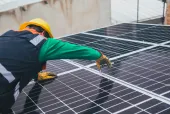India – the single largest opportunity in solar power in the world
By Agostinho Miguel GarciaIndia’s Jawaharlal Nehru National Solar Mission is bound to achieve 20 GW until 2022. India has some KW of installed solar power until the kick start of the Mission in 2010. India is one of the two countries in the world with more than one billion and is also home to many persons without electricity. But we are not talking about off-grid applications, we are talking about on-grid and with Fit. India learnt the lesson of Fit and RPS driven PPA and created their own scheme: RPO – Renewable Purchase Obligation – with a reverse bidding to determine the Fit.
The results have been astonishing. The first phase has seen 1000 MW being bid and 500 MW went for CSP while 500 MW went for PV. The quoted prices of Fit for PV were around 7,49 INR (around 0,15 USD). Fit of Italy around 0,4 eur, Fit of Spain around 0,3 eur and Portugal around 0,25 with good solar radiation are actually higher than the Fit of Germany 0,18 eur, so are these values in India so astonishing? India displays plenty of sites with 6 Kwh/m2 and above, while Germany hardly reaches 4,5 Kwh/m2!
Indian Fit scheme grants 25 years at the auctioned price and here the lessons learned seem not to be taken into consideration. Why no bid for the timeframe? Why 25 years? Why not an energy limitation like the Portuguese Fit instead of time frame? States as Gujarat and Rajasthan have witnesses the largest interest, leaving other states wishing for some attention. State initiatives as the one in Karnataka pledge to at least have some power installed on their states and not only on the Indian solar states. Hopefully Tamil Nadu and Andra Pradesh will follow with their own solar state policies.
Why is India not in the solar map? Why is India being overlooked? Why is one of the largest countries in Asia and one of the largest potential for Asian power generation being forgotten?
Some say the cost of financing, some say financing availability, some say bankability, some say: not viable. India’s top companies are involved and gearing to have their own MW being it at the easy PV or the more complicated CSP. India’s top banks are also involved, so what is missing? Foreign participation seems shy for such a large potential.
Will India keep its solar revolution indoor? Why are Asian investors not investing? Why are Koreans and Chinese absent from the market as developers? Why are Chinese only supplying and complaining about the low price of Indian purchases?
India seems to lead the solar revolution in Asia, but it needs the participation of other asian countries. That interest may spark the revolution on other countries and if pieces in India come to 6 INR – the grid cost – will 20 GW continue to be the target for 2022?














 Advertise
Advertise











